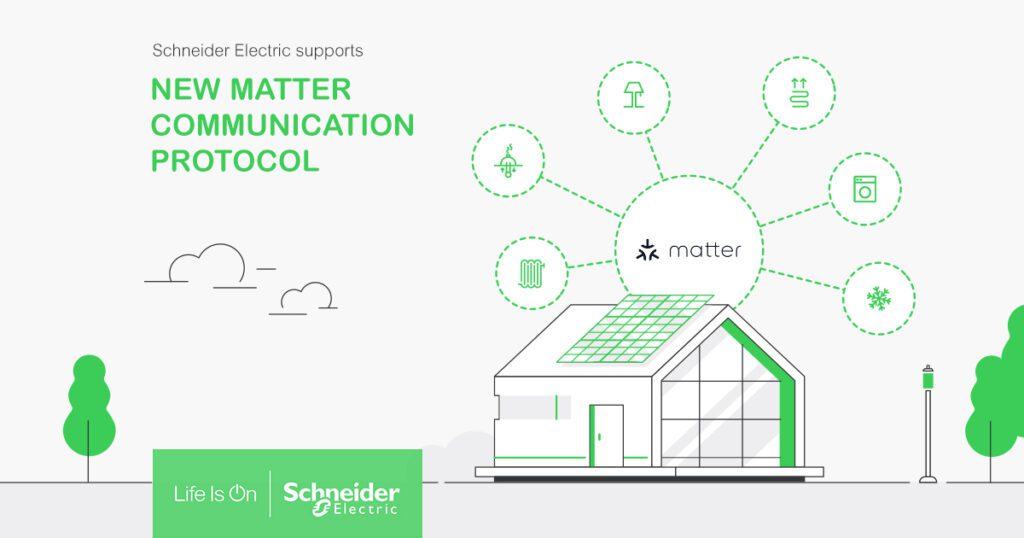At Schneider Electric, we believe all of us have a role to play in protecting our planet, and every step counts. With these talks, we are exploring the different bricks which can make our homes more efficiency and more sustainable.
So, this time around we have Arseni Faber talking about Matter; the new home IoT communication protocol. Arseni is the lead on device connectivity for our smart home offer, Wiser. In his role, he works extensively on how Schneider Electric engages with Matter.
You must be wondering, “What is the Matter protocol and how can it make homes more sustainable?” Matter is a new unifying IP protocol designed to make smart home a simple and seamless experience for consumers, making things truly and natively interoperable between each other. At Schneider Electric, we are strong believer that interoperability and openness are critical to make our homes not only smart, but smart and sustainable.
And with Matter, we can augment the capabilities of our Wiser HEMS (Home Energy Management System) that monitor their energy consumption but also save their energy bills.
This blog will take you through the journey of Matter, the role of Schneider Electric in Matter and how we believe Matter will play it part in the sustainability and energy efficiency journey, and all your why is and how it would be answered.
Host: Johanne Guigue, Home and Distribution Communications Leader, Schneider Electric
Guest: Arseni Faber, Senior Manager – Wiser Edge, Devices Connectivity & Cyber Security
This talk covers:
- What is Matter and why is it an important checkpoint for the smart home industry?
- How will Matter enhance sustainability and energy efficiency in homes?
- How is Schneider Electric preparing for the new connectivity standard?

Johanne: Before we answer how Matter plays a vital role in making homes more sustainable, I’d like to ask you a simple question: what exactly is the Matter communication protocol?
Arseni: Matter is the name of a new Internet of Things or IoT connectivity standard. It is designed to allow interoperability across systems and devices made by different vendors. Up until now, the adoption of smart technology in homes has been hampered by the fragmentation of various specialized connectivity protocols, especially between different devices and brands. However, customers expect a consistent and simple experience when they use their IoT devices. They just want the devices to work! After all, they are not system integrators and cannot spend hours to make things connect and communicate.
Matter is designed to be simple, interoperable, reliable, and secure. It relies on IP connectivity, the de facto standard communication protocol of the Internet and will support IP protocols such as Wi-Fi and Thread. BLE is also supported for commissioning purposes.
As a single, unified connectivity standard, Matter is expected to drive massive adoption of smart home technology. Schneider Electric welcomes Matter as it unleashes the potential of smart technologies in homes of the future.
Johanne: From my understanding, Arseni, Matter is the unique, collaborative effort of many players in IoT. I’ve heard that almost 250 companies have shown their support in one way or another.
Can you walk us through the Matter story? How did it start? Who is behind it?
Arseni: As you said, Johanne, Matter is a fantastic collaborative effort, announced in December 2019. The project started as part of the Connectivity Standard Alliance – previously known as the Zigbee Alliance, of which Schneider Electric is a promoter and board member. Back then, the project was called CHIP or Connected Home over IP. A large number of major IoT companies have been part of the project since the beginning.
In May 2021, the Connectivity Standards Alliance announced the creation of Matter, the new name of this communication standard. Today, almost 450 companies are part of the alliance, including Amazon, Apple, Google, and Schneider Electric.
Matter has many technical advantages because it is based on modern system design practices. But it’s the magnitude of collaboration across so many companies that really makes the Matter story remarkable. All of us are working towards the same objective: to assure interoperability and a consistent user experience.
You know at Schneider Electric, we are optimistic people. So as a company with a strong belief in interoperability and openness, we welcome Matter as a unique opportunity to make smart homes a consistent, holistic, and satisfying customer journey from start to finish.
Johanne: Arseni, you referred to Matter as a game-changer. That makes me think of another question: How will Matter help solve the energy dilemma we currently have in homes? On the one hand, we want to reduce energy consumption in our homes, which is a necessary step to save the planet since residences today already represent 20% of carbon dioxide emissions. On the other hand, Matter will allow us to add more and more connected objects, all reliant on electricity, and all reliant on the Internet, powered itself by electricity.
If I may ask, will we see our energy bills skyrocket to make all of this work together?
Arseni: That’s a great question, Johanne, and an important one. Because we are truly at a pivotal moment.
At Schneider Electric, we believe that connectivity is one of the main enablers of energy savings because it allows devices to work together as a system. With such a system in place, we can more quickly and easily identify appliances that consume lots of energy. We can alert customers to savings opportunities and help them operate devices only when they are needed and when green or cheap energy is available. Not only will they save energy in their home and reduce their carbon footprint, they’ll also increase their comfort at the same time.
And here’s the best news: the technologies exist to make this happen TODAY!
- Smart technology informs smart decision-making: if an outdated refrigerator is wasting energy, you will be alerted and can take action.
- Smart technology gives you smart advice: you will know how much energy your heating system is consuming and get concrete recommendations on how to reduce that consumption.
- And last, smart technology drives smart and optimized performance, thanks to intelligence and AI.
If you combine the three factors I just listed:
- Better interoperability thanks to Matter
- Electrification and digitization of homes and
- A complete home energy management system
You can make homes smart and sustainable at the same time. So that’s a long way of saying: with Matter, the more devices we connect in a single ecosystem, the better we can manage and control our energy.
Johanne: If I understand correctly, Arseni, technology is ready to make homes consume less energy, while at the same time keeping them consistently comfortable. Correct?
Arseni: In fact, you will be more comfortable. I said at the outset that Matter was designed with simplicity and interoperability in mind. Ultimately installers and end users will have a consistent experience from purchase to usage. And they will be able to use their favorite interface such as Amazon’s Alexa or Apple’s Siri to operate these devices.
That’s why we say that Matter will help us accelerate the push to make our homes more sustainable. The less energy we use, the less our homes produce CO2 emissions. Matter as a standard will grow, and by integrating new technologies, Matter can help pave a pathway to self-sufficient, net-zero homes, while reducing e-waste and improving circularity. For example, the solar panels on your roof will generate the electricity that heats your home and water…
As I said earlier, today we estimate that the energy production in homes – houses and residential buildings – is responsible for roughly 20% of CO2 emissions. Home are also projected to become the single largest consumer of electricity by 2050. Yes, your home alone is like a drop in the ocean. But when you combine all our homes, they represent one-fifth of greenhouse emissions worldwide. As a consequence, all drops do matter.
That’s why we are so keen to say that every little step is important. At scale, these small numbers will add up to make a big impact. Every one of us has a role to play to make the planet greener.
Johanne: If I read in between the lines, Arseni, you are saying that we need to make these technologies known to the public. Many people are unaware of the simple things they can do to make their home more energy efficient and more sustainable. And that Matter can be an enabler to accelerate sustainability in their homes.
Let’s come back to Matter specifically, Arseni. Can you explain in simple words how Matter will operate?
Arseni: I will do my best! Matter is an open source, IP-based connectivity standard that makes it easy for all the devices in a consumer’s home network to communicate with each other. In other words, it lays the groundwork for smart home ecosystems that are organized around a unified networking protocol and connectivity standard, not around an individual vendor’s proprietary technology.
Think of it this way: at the United Nations, translators enable people who speak different languages to communicate with one another. In a smart home, Matter serves as the translator between a host of different devices with different languages.
In terms of more technical specs, the Matter standard will utilize TCP and UDP at the transport layer, and IPv6 at the internet layer, while initially defining three networking technologies – Wi-Fi, Thread, and Ethernet.
Johanne: How will a system that is Matter-enabled also support existing or other protocols?
Arseni: You bring up a great point! Matter is interoperable even across networking technologies so device manufacturers can pick the right technology for each application. But Matter also offers a concept called “bridging”, which allows non-Matter protocols to be translated into Matter so that those devices can continue to operate in a Matter environment. And this is a very important concept to understand, especially as it pertains to sustainability.
The fact that your voice controller becomes part of a Matter-based network doesn’t mean you’ll have to install a new shutter control or security system to make it compatible. Our customers expect our devices to operate for many, many years and those devices are often part of the electrical infrastructure. Matter adopters will be able to operate a hybrid Matter/Zigbee network, so you can continue to say, “OK Google, close the living room shutters.”
We respect our customers’ investment in our systems and want to give them the best possible Matter experience with the fewest changes. This is our strategy at Schneider Electric. At IFA 2022, we are demonstrating our very first Matter-ready Wiser controller, which will serve as a bridge for our Zigbee devices so our customers can integrate their Wiser devices into a Matter ecosystem. There is no need to change their connected devices. This feature will be launched shortly after the release of Matter.
Johanne: So we understand that in the very near future, it will be easy for consumers to set up a complete ecosystem of devices communicating one with another. What other benefits does Matter offer to consumers?
Arseni: Earlier I mentioned the benefits that Matter delivers. Now I’d like to emphasize two in particular: reliability and security. You know, after interoperability, data privacy and security top the list of concerns that consumers have with the adoption of smart technology. In a recent survey conducted by Schneider Electric, half of the consumers polled said they are concerned that smart home technology is making them vulnerable to cyber-attacks, and the same percentage is worried about their privacy.
Manufacturers have a duty to reassure consumers and build cybersecurity by design. One of the great things about Matter is that it provides guidance on selecting the appropriate platform security. I will not detail here the layers of security, but a large number of proven security features have made their way into the standard. And the best thing is, everyone can verify that their platform is secure since Matter is open-source.
Furthermore, as Matter is built on top of the language of the Internet, we expect it to bring enhanced reliability to the network, as well, with a consistent and responsive local connectivity.
Johanne: So, to summarize Matter’s key features: interoperability, reliability, security, and simplicity for consumers. That’s the marketing pitch, but I understand that we at Schneider Electric are very optimistic that this can be translated into concrete benefits for the users.
Arseni: Yes, exactly. This is the reason why Schneider Electric has dedicated resources to the development of Matter, together with our partners, and this is why we have worked extensively within our own product development teams to provide a consistent Matter-ready ecosystem.

Johanne: So can you explain the Schneider approach to make our solutions Matter-compliant?
Arseni: Sure, we’ve taken a simple three-axis approach:
First and foremost, we respect the investment our customers have made in ZigBee devices. So with the already-mentioned bridging functionality, we will allow existing installations to join Matter systems.
Second, some of our offers will be upgradable to be Matter-compliant via a simple software upgrade. These first two axes ensure a sustainable approach where the installed base of devices does not become obsolete with the arrival of the new standard.
With the last and third axis, we are actively working to evolve our first ranges of switches and sockets to be Matter-compliant, once the certification is open, for two key markets – Europe and the US.
The Wiser gateway and switches are first in line to be Matter-certified.
Johanne: So, what do you suggest to our listeners now? What steps can they take to make their smart home ecosystem Matter-compliant?
Arseni: I invite you all to join us at our booth, where we are demonstrating how we are turning the promise of Matter into reality in homes around the world. Let’s continue the conversation and explore further about our mutual passion for smart technologies in homes.
Johanne: Thanks a lot, Arseni, for being with us today. I hope our listeners, both here and online, have a clearer understanding of the Matter connectivity standard concept.
Listen to the complete talk here
Learn more about building sustainable homes of the future



